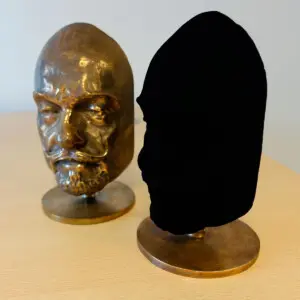How Vantablack coating has shaped nanotechnology
What if I told you there was a substance so black that it could make an object disappear? This technology is called Vantablack, an acronym for Vertically Aligned Nano Tube Array Black. It is a forest of parallel carbon nanotubes, strong microscopic tubes entirely made up of carbon (2). When news of Vantablack first broke in 2014, some experts believed that it would be used to make invisible military equipment such as jets, but this coating can easily be tarnished by human touch, ruining this possibility (1, 2). However, Vantablack has many more practical applications. Able to absorb 99.965% of visible light as well as ultraviolet and infrared light, the only thing darker than Vantablack is a black hole (1, 4).
Vantablack was created by British Company Surrey NanoSystems, and took the world by storm with a variety of important uses (2). Chances are you’ve heard of Vantablack before. Artists have integrated it into pop culture by using it to make three-dimensional objects appear two dimensional in highly alluring paintings. One such artist, Anish Kapoor, who bought the artistic rights to the substance, has created some of the most famous works of art employing Vantablack (8). Since Vantablack’s inception, it has also been used on a European microsatellite. One of Vantablack’s main applications is absorbing the stray light, and in the case of the microsatellite, it helped to chart its course through the stars (2).

To make Vantablack, catalyst particles, which are zero to two nanometers wide, interact with gas, causing these particles to grow into carbon nanotubes (2). Because the nanotubes are perfectly spaced, light is able to “fall” into the holes in the tubes and be absorbed (2). The minimal amount of light that is still reflected from the surface is due to the remaining surface area at the top of the tube (2). Carbon nanotubes were invented in 1991, and created a new type of science — nanoscience (7). While other carbon nanotube forests have been constructed by major space agencies such as NASA, they are approximately 0.06% less absorbent (2).

Vantablack’s complexity goes beyond its thought-provoking color. The Surrey NanoSystems website defines four specific applications of Vantablack in engineering: space and technology, lenses and optical systems, automotive sensors, and special projects (5). The most fascinating of these applications is the use of Vantablack in HUDs, or head-up displays, a holographic version of typical dashboard indicators (6). Vantablack can be used in these displays to eliminate excess light, allowing for a more seamless driving experience and less eye strain due to increased contrast (6). Vantablack’s applications are boundless, and many more are sure to be discovered in coming years as it expands into self-driving car sensors.
Bibliography:
- YouTube. (2018, May 20). Vantablack – the darkest material on Earth. YouTube. Retrieved January 22, 2022, from https://www.youtube.com/watch?v=fg2x0L4YAuU&vl=en
- Bullen, J. (2017, January 15). Blacker than black: How the world’s darkest material is being used. ABC News. Retrieved January 22, 2022, from https://www.abc.net.au/news/science/2017-01-13/vantablack-where-is-it-being-used/8175042
- Vantablack. ColourLex. (2021, February 26). Retrieved January 22, 2022, from https://colourlex.com/project/vantablack/
- buzzfeedblue. (2016, July 8). The world’s blackest material – an inside look at Vantablack. YouTube. Retrieved January 22, 2022, from https://www.youtube.com/watch?v=BkGHwrq2Eho
- Vantablack – black absorber coatings for calibration and Stray Light Suppression. Home. (n.d.). Retrieved January 22, 2022, from https://www.surreynanosystems.com/applications
- Vantablack – black coatings for stray light control in Automotive Camera Shields, LIDAR, WHUD, headlights and HUD Systems. Home. (n.d.). Retrieved January 22, 2022, from https://www.surreynanosystems.com/applications/automotive
- Sponsored by Cheap Tubes Inc.Apr 23 2018. (2019, September 26). A history of carbon nanotubes. AZoNano.com. Retrieved January 22, 2022, from https://www.azonano.com/article.aspx?ArticleID=4843#:~:text=In%201991%2C%20Iijima%20discovered%20carbon,of%20dollars%20have%20been%20invested.
- Hills, M. C. (2021, August 20). The ‘blackest’ black: How a color controversy sparked a years-long art feud. CNN. Retrieved February 4, 2022, from https://www.cnn.com/style/article/blackest-black-ink-culture-hustle/index.html

